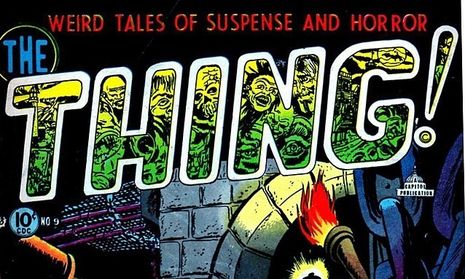Practical effects and variety are the key to successful body horror
After watching the 2022 re-release of the 1982 ‘The Thing’, Daisy Cox feels nostalgic for the horrifying success of practical effects and laments the overuse of CGI in modern horror

Content Note: This article contains detailed discussion of gore and body horror.
This article also contains spoilers for ‘Men’ and ‘The Thing’.
It is no understatement to say that John Carpenter’s The Thing (1982) is one of the best (if not the best) horror films of all time. Certainly, I would suggest that it showcases the best use of practical effects ever put to film, and the use of body horror to engross the viewer in its own sinewy plot remains exemplary for many modern directors today. Rob Bottin, the visual effects maestro who created all of the iconic gory moments we see on-screen, was famously hospitalised after staying up long, painful hours to make sure everything about his grisly masterpieces were perfect. It is no wonder that his name is emblazoned in the opening title sequence alongside that of Carpenter; after all, it was Bottin who first visualised such iconic creatures as the fleshy-spider that stalks the hallways of the Antarctic base, and the infamous CPR arm-ripping chest scene (which itself was created using false-arms filled with blood and gore – a delightfully effective stroke of genius that leaves the audience speechless).
“When it comes to gore ... nothing comes close to the effectiveness of practical effects”
Indeed, having rewatched The Thing in cinemas, I gained a newfound appreciation for Bottin’s work when projected on the big screen. It’s simply shocking to me that, when originally released in 1982, the film was met with negative reviews (even being nominated for ‘Worst Musical Score’ at the Razzies that year). Thankfully, as a means of vindicating this most grievous crime, The Thing is now rightfully celebrated as a work of art within the horror genre.
However, seeing The Thing projected also reminded me of my recent viewing of Alex Garland’s Men; namely, just how much more effective practical effects are in comparison to their digital counterparts in creating body horror. If you have not seen Men, or had the miserable experience of watching the final sequence, here’s a summary: Jessie Buckley stands unbothered as she watches multiple clones of Rory Kinnear fall pregnant and burst out of each other’s bloodied bodies, all while groaning and screaming to a very confused audience. This is certainly not a sight for the faint of heart – when I saw this final climactic scene in Men, I was left with my mouth open.
However, this was not due to the actual gore and body horror I was being presented with on screen; I was more stunned by this grotesque concept, rather than by its execution. Indeed, my apathy towards the visual body horror of what was being shown reached its peak when, by the time that the priest version of Kinnear comes screaming out of prior-Kinnear’s bloodied pregnant husk, I felt a yawn coming on, and it became increasingly hard not to think about my shopping list while I sat impatiently in my cinema seat.
Many in the audience felt the same way – by the time Garland’s pregnancy pain-train finally ended, and we were all, at last, released from the screening, a chorus of confused and slightly annoyed conversations echoed all around. Why did we have to see that five times to get the message? And why did the digital effects not really hit home? Once you’ve seen it happen already, the final act of Men becomes a chore in messy digital effects with gore haphazardly splattered all over it.
“Once you’ve seen it happen already, the final act of Men becomes a chore in messy digital effects”
This is all in contrast to the effects utilised in The Thing – a film that predates Men by four decades. The key to Bottin’s success throughout is both his masterful employment of practical effects (something that has been sadly replaced with computer generated imagery, or CGI, in most modern horror films), as well as the variety in the gruesome creatures he creates. From the churning mass of limbs and guts that we first see rising out of the dog that the doomed crew let in from the cold, to the facial assimilation and uncertain fate that Garry (Donald Moffat) faces in the climactic final 20 minutes of the runtime, Bottin and Carpenter take every opportunity to present the audience with a new, horrific visual treat.
All of this variety is lost in Men. Sure, the dangling hand that Kinnear brandishes to a terrified Jessie Buckley is rather grim, but is it really all that shocking after we see one of Kinnear’s characters stride on screen with it for the third time? Is it all that effective to see Buckley’s abusive ex-husband burst from the reddened gory mass of pregnant Kinnears when you’ve already had to sit through ten minutes of it prior?
Personally, I think not. With this 40th anniversary re-release of The Thing, I hope that aspiring horror directors take note of just how much more effective body horror can be in variety, and by the use of practical effects.
Though CGI has certainly allowed many filmmakers to push the boundaries of what can be visually achieved on screen, when it comes to gore, violence, and other miscellaneous-bodily-mutilations, nothing comes close to the effectiveness of practical effects – and, until that becomes known, I think it is unlikely that any film will match the sheer visual horror of The Thing for many more years to come.
 News / Uni Scout and Guide Club affirms trans inclusion 12 December 2025
News / Uni Scout and Guide Club affirms trans inclusion 12 December 2025 News / Cambridge Vet School gets lifeline year to stay accredited28 November 2025
News / Cambridge Vet School gets lifeline year to stay accredited28 November 2025 Science / Did your ex trip on King’s Parade? The science behind the ‘ick’12 December 2025
Science / Did your ex trip on King’s Parade? The science behind the ‘ick’12 December 2025 News / Cambridge study finds students learn better with notes than AI13 December 2025
News / Cambridge study finds students learn better with notes than AI13 December 2025 News / Pembroke to convert listed office building into accom9 December 2025
News / Pembroke to convert listed office building into accom9 December 2025








